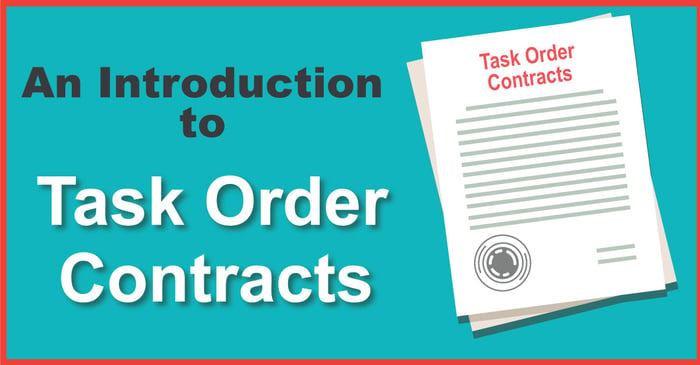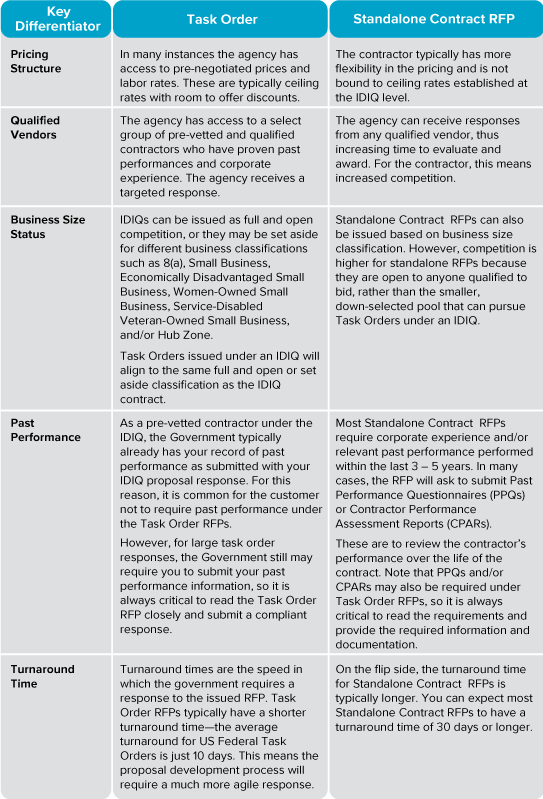
If you’re new to Federal Government contracting, you may be overwhelmed with all the new terminology and the many different procurement and contract types you hear about.
One special type of request for proposal (RFP) you might encounter is a Task Order RFP. If you want to learn more about Task Orders and how to approach them, this article is for you. This article provides an introduction to Task Orders and highlights the following:
- What constitutes a Task Order?
- Are there differences between a Task Order and a Standalone Contract RFP?
- Who can respond to Task Orders and common teaming structures
What Constitutes a Task Order?
To understand what Task Orders are, we must first explore their origins. Task Orders directly result from an award made under an Indefinite Delivery Indefinite Quantity (IDIQ) contract. An IDIQ contract provides an indefinite quantity of services for a fixed time.
Under the IDIQ contract, the government places delivery orders (for supplies) or task orders (for services) against a basic contract for individual requirements. Therefore, the IDIQ does not specify exact quantities of products or services being procured other than the minimum or maximum quantities.
These products, services, or quantities can be many things, such as the people, laptops, labor hours, systems, applications, help desk, printers, machines, phones, logistics, materials, and/or locations.
For a Task Order, the agency provides specifics and describes the overall scope, project background, and Performance Work Statement/Statement of Work. This provides the contractor an understanding of the requirements, the current state of the contract, the agency objectives, and the agency’s desired future state.
A Task Order can be used for new, ongoing, or repeatable services. In turn, the bidding contractor provides the agency with an innovative solution and pricing for the requirements outlined in the Task Order. This results in the issuance/award of orders for the desired performance period, typically one base year and four option years.
The graphic below illustrates the lifecycle of a Task Order from RFP release to submission.

Are there Differences Between a Task Order and a Standalone Contract RFP?
There are more similarities than differences between a Task Order and a standalone contract RFP. Responding to an IDIQ RFP is essentially just like responding to any other RFP. However, a few slight differences range from pricing style and structure, bidder qualification, bidder size and status, past performance, and turnaround time.
The table below provides a detailed description of each of these identified components.

Who Can Respond to Task Orders and Common Teaming Structures
A teaming structure can vary depending on the size, scope, and complexity of the Task Order. However, to be eligible to respond to a Task Order, a company must have either been an awardee of the IDIQ contract themselves or be a subcontractor under a prime who has been an awardee of the IDIQ.
This gives only those companies/awardees an exclusive opportunity to respond to Task Orders when they are released. Task Order teams can take many forms. However, companies team with other companies to increase their chances of winning the contract in almost all instances.
A few of the most common types of teaming structures are described below:
- Prime/Sub – This is the most common teaming structure for Task Orders and standalone RFPs. The Prime contractor subcontracts work to another company to perform a portion of the work, usually in a field or position that is out of scope for the prime contractor. Large businesses also frequently subcontract niche work to small businesses to meet specified small business goals.
- Mentor/Protégé – This program allows small businesses with industry experience to partner with larger and more experienced businesses to establish their own best practices and navigate the government contracting environment. Some RFPs will require large businesses to have one or more established mentor/protégé arrangements.
Conclusion
Once your company is awarded the IDIQ contract, you are eligible to bid on any upcoming Task Orders under the specific IDIQ contract. While there are many similarities between Task Orders and standalone RFPs, the key differences to note are the decreased competition from the outside market, increased competition from other qualified and pre-vetted vendors under the IDIQ, and a shorter average turnaround time. Reduced competition from other vendors can increase your win probability and reduce the burden on the Government to evaluate the smaller pool of responses received.
If you want to learn more about how setting up a Task Order response process can help you win, check out this article. If your organization needs the support of experienced proposal managers and writers to successfully respond to Task Orders, KSI is here to help!








